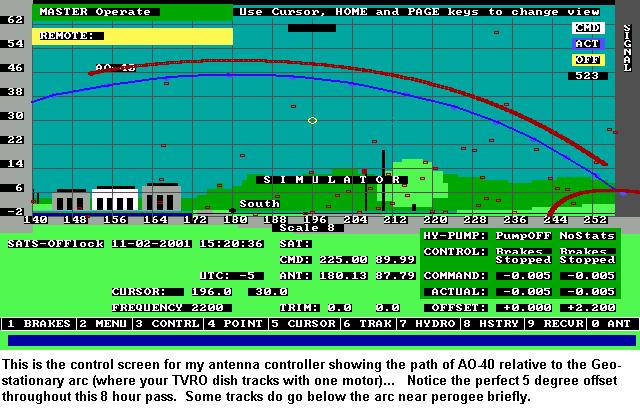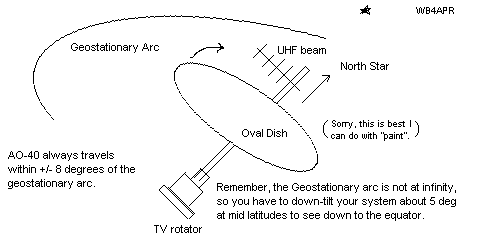 APRS on AO-40
APRS on AO-40
 APRS on AO-40
APRS on AO-40
Operating a single APRS channel on AO-40: Since AO-40 is the primary bird in the AMSAT inventory that provides hemispherical coverage to all corners of the globe for many hours a day, it is reasonable that we establish a permanent APRS channel on the transponder. This can serve to link remote travelers back into the global APRS system. This permits live real-time communications between the remote operator and his intended target anywhere on the globe and only he needs the AO-40 portable station. The plan is simple. A net control station (one per continent) establishes a constant PSK signal uplink channel fed from the APRS-IS. This gives users something to tune in and lock on to as shown below. We will use PSK-31 as the modulation mode because of its excellent weak signal characteristics and ready availability to all radio amateurs. (And many other factors discussed later).

Then exactly 1000 Hz higher is where the SATGATE station is listening for remote APRS user uplinks. If the DSP software was smart enough, it couild accept multiple uplinks over a range of frequencies offset from the pilot channel. The SATGATE station will take these and then feed anything heard into the global APRS-IS!

SATGATE UPLINK: The APRS to PSK-31 conversion will convert all APRS position data (that uses the ALTNET address of "AO40xx") to a simple 6 character gridsquare as shown above. Any PHG is dropped and the course and speed is only included if the station is moving. Otherwise the position comment text comes through as written. Notice that the callsign suffix is repeated as a redundancy check and the grid square is case sensitive to allow for context checking of information validity. PSK-31 has no inherrent error detection, so these techinques allow some rudimentary sanity checking of data that can be Human read and manually entered. Thus the PSK-31 AO-40 user needs no special software to join the Global APRS system. Typically, he would prepare his basic Gridsquare format in one of his transmit buffers to trnsmit at the beginning of any QSO exchange.
The AO40 ALTNET: Traffic from the global APRS-IS intended for this SATGATE uplink will use the APRS alt-net concept. Any packet on the APRS-IS originating anywhere on the planet can be routed to the SATGATE uplink by simply using the ALT-NET address of AO40xx. This is a valid ALTNET TOCALL that will not impact normal APRS functionality but it signals the SATGATE to include it in the live uplink. There is not need to carry this through the conversion to PSK-31 because it is assumed that ALL packets on the pilot uplink meet this criteria. SImilarly, when PSK-31 user generated position data is captured from user uplinks and converted to normal APRS position or message packets, by the SATGATE for injection back into the APRS-IS, then those packets will contain not an ALTNET tocall, but a normall APRS tocall of "AP40xx" so that they are seen by any APRS station through the normal APRS filters. But the "AP40xx" gives a unique identifier that the packets came into the system via AO-40. Probably we can use the availablle two XX characters to indicate the identity of the SATGATE...
WHY PSK-31? There are several reasons why PSK-31 and this full duplex
pilot uplink system is the mechanism of choice for this APRS channel on AO-40:
Some AO-40 BASICS: All it takes to communicate with AO-40 is a small dish
on the order of a meter across and a UHF transmitter good for 50W or so and a small
UHF beam. These can easily fit in a suitcase for travel as indicated below:
AO-40's ORBIT: AO-40 follows the same arc across the sky everyday
but at different times as shown below. And this arc is just the projection of the Earth's
equator onto the sky. It goes from horizon to horizon beginning in the East and
ending in the West and due South it is up an angle equal to 90 minus your
latitude (in the northern hemisphere). By simply pointing the axis of your dish rotator at the north star
(simply North and tilted at an angle equal to your latitude) then you only have
to swing the dish left and right to find AO-40. Because of AO-40's very high
orbit, it is in view for 8 hours or more at a time. You can even add a simple
dipole feed to your backyard satellite dish if you like:
Easy, TV rotator (no elevation) tracking system!

If you have a good downconverter, low noise pre-amp and circular feed and can hear AO-40
on a "prime-star" type eliptical dish, all you need to track AO-40 remotely is a simple
TV rotator. Just point the axis of the rotator at the north star, mount the dish and your
UHF uplink beam to the tilted mast, and you can track AO-40 horizon to horizon with
just the $65 TV rotator from Radio Shack. This is beacause the vertical beamwidth of
the oval Primestar dish is about 20 deg, wide enough to always see AO-40 along the
geostationary arc as shown below:
 click here if image is broken
click here if image is broken
APRS AO-40 SATGATE DETAILS: There are several things that the SATgate software
should do to facilitate the proper operation of this system.
You are visitor number:
Since 27 Oct 2003.
Return to the APRS HOMEPAGE